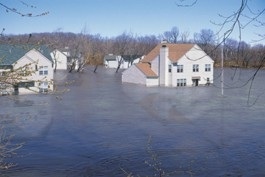 RISMEDIA, March 23, 2011—(MCT)—The frightening images of Japan’s tsunami wiping out homes, roads and entire cities are vivid reminders that a natural disaster can strike at any time.
RISMEDIA, March 23, 2011—(MCT)—The frightening images of Japan’s tsunami wiping out homes, roads and entire cities are vivid reminders that a natural disaster can strike at any time.
And whether it’s an earthquake, a wildfire or flooding, being covered against severe damage to your home or business is essential.
Across the United States, flooding is the No. 1 natural disaster, according to the Federal Emergency Management Agency.
And given the region’s swollen rivers and the promise of heavy runoff this spring from melting snow, now is a good time to assess how well you’re protected against flooding.
A basic homeowner’s or business’ insurance policy will cover damage caused by storms, such as a leaky roof, fallen tree limbs or broken pipes.
But a homeowner’s policy typically does not cover damage due to flooding, or what’s known as “rising water.”
Flooding—such as a levee break, a river overflowing its banks or water from springtime snow melt—is generally defined as a temporary inundation of normally dry land. For that type of coverage, you need a separate flood policy, which is provided by the federal government’s National Flood Insurance Program and purchased through a local insurance agent.
“The distinction is that homeowner’s insurance covers water falling from the sky; flood insurance covers water rising from the ground,” says Tully Lehman, spokesman for the nonprofit Insurance Information Network of California.
In some areas, flood insurance is required, particularly in high-risk areas. “In other areas, flood insurance is suggested but not mandatory,” says Vince Wetzel, the Sacramento-based spokesman for State Farm Insurance. “People need to evaluate the costs and (flood) risks and decide for themselves.”
Flood insurance covers most damage to your home, business and personal property caused by temporary inundation of water. It includes mudflows, but not landslides.
One limitation to flood insurance is basements. Improvements such as sheetrocked walls, finished floors and personal belongings in a basement are not covered by flood insurance; essential household equipment such as furnaces or water heaters is covered.
For residential policies, the maximum coverage is $250,000 for the structure and $100,000 in personal property. For a business or commercial property, the maximum limits are $500,000 structural and $500,000 in contents.
Flood insurance premiums vary, depending on where you live and whether your home is considered at high or low risk of flooding.
The average residential flood insurance premium is about $570 per year, according to the NFIP. But homeowners in low-risk areas can purchase coverage for as little as $129 a year; those whose homes are in heavily flood-prone areas will pay $2,700 or more in annual premiums. Commercial property rates are higher. See www.floodsmart.gov for details.
And keep in mind: If you get a policy today, it doesn’t go into effect until 30 days after it’s purchased.
Regardless of whether you purchase flood insurance, it’s a good idea to conduct a home inventory.
Here’s a test recommended by insurers: Sit and mentally visualize everything in your living room, from the TV to the bookshelves to the candle collection on your mantel. Got your list? Now walk through the room itself, seeing all the items you missed.
It’s easy to underestimate the number and value of possessions, from major appliances to decorative objects. But in the event of a disaster, you want to be able to get reimbursed for your losses.
Doing a home inventory can help with replacement costs for any type of damage, whether it’s a flood or other disaster covered by your regular homeowner’s policy.
If you don’t have an accurate inventory and your policy “only lists that 12-inch TV from your college days and doesn’t include that big flat-screen TV you bought,” you could be vastly underinsured, says Lehman.
The same goes for home-remodeling projects.
“Any time you do changes, such as kitchen and bath upgrades, you want to be sure your homeowner’s insurance policy includes that information,” says Lehman. “If you’ve gone from Formica countertops to a nice marble or granite, or from a Frigidaire to a SubZero refrigerator,” you should include those improvements, he says.
To do a home inventory, walk through your house, room by room, with a video or regular camera, photographing major objects, such as furniture, electronics, etc.
If using a video camera, talk and describe the room and its contents. If taking still photos, date and label each photograph with details. Jot down serial numbers for major appliances and electronics.
You can file everything in a binder, on a CD or on your computer, ideally with copies of sales receipts for major purchases, such as electronics, appliances, furniture, etc.
Websites, such as the California Department of Insurance (www.insurance.ca.gov) or the Insurance Information Institute (www.knowyourstuff.org), have handy inventory planners that you can print out or download. And, of course, there’s an iPhone app, too: “Home Inventory.”
Keep a copy—along with your insurance policy and insurance agent’s contact information—in a secure and waterproof place: a safe-deposit box, a home safe or in a separate location, such as with a trusted family member.
Like Hurricane Katrina, which set records in the United States six years ago for water-related insurance claims, the overwhelming losses suffered by individuals and families in Japan can serve as a wake-up call to be prepared.
“Whenever a disaster like this happens, it makes people question: If this were to happen here, what do I need to do to be covered?” says State Farm’s Wetzel. “It makes you re-evaluate.”
(c) 2011, The Sacramento Bee (Sacramento, Calif.).
Distributed by McClatchy-Tribune Information Services.










